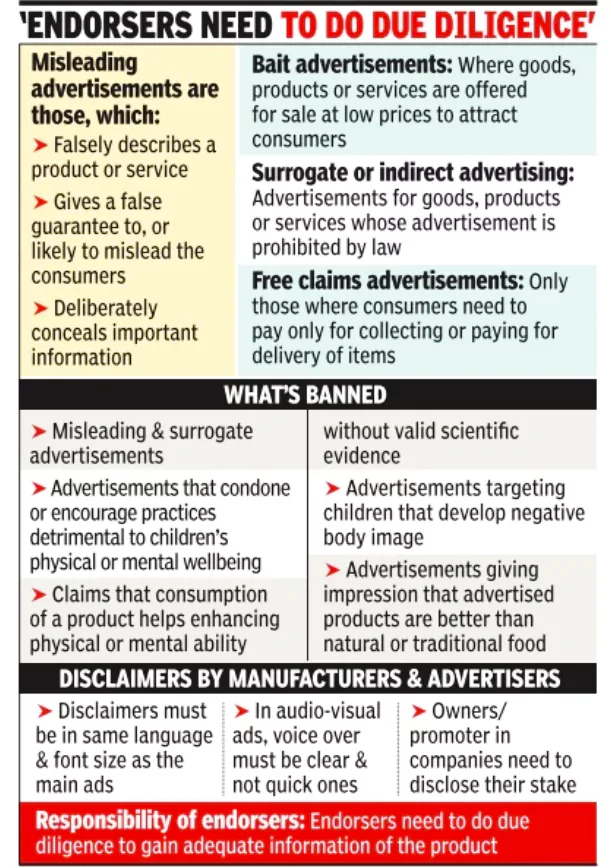Context
Recently, the Supreme Court prohibited Patanjali Ayurved Ltd from issuing false advertisements about the medical efficacy of its products and issued contempt notices to the business for breaking a prior promise.
Issues With Patanjali’s False Claims
- Ethical issue: The Misleading advertisement affects consumer trust and the business’s integrity. The controversy shows the consumer’s susceptibility, as they trust that some regulating authority has ensured that nothing harmful, hazardous, or useless is sold as medicine.
- Violation of Legislations: The Indian Medical Association (IMA) argued that Patanjali’s advertisement headed “MISCONCEPTIONS SPREAD BY ALLOPATHY” violated legislation governing medication regulation. It was a direct violation of the Drugs and Other Magical Remedies Act of 1954 (DOMA) and the Consumer Protection Act of 2019 (CPA).
- Adverse health impact: Unverified products can harm consumers’ health. There is a larger risk with such pharmaceuticals (of which Ayurveda accounts for more than 75%), because the user assumes that all items are natural and therefore safe.
- Misleading advertisements: These Misleading advertisements have increased the number of incidents of self-medication due to their claims of effective therapy and cure for intractable conditions.
- Inactions of government and regulatory bodies: Even as the claims are made with increasing impunity, no tangible action appears to have been taken by the state governments to which the Ministry of Ayush has filed hundreds of complaints. The Advertising Standards Council of India, a regulatory body, has also failed to take any action or establish norms.
- Inadequate legislation: There is a lack of adequate legislation governing the regulation of such drugs and advertising.
- For example, the rules of the DMR Act are distinct, limited, and particular, as they were intended to regulate deceptive claims and ads involving medical drugs and products.
- Whether the items have been licensed or not, whether they are evidence-based or not, and if R&D has been conducted falls outside the scope of DMR.
What is a Misleading Advertisement?
The Consumer Protection Act of 2019 defines a misleading advertisement for any goods or service as one that:
- Falsely describing a product or service
- Providing a false guarantee
- Making an express or implied representation that would constitute an unfair trade practice
- Concealing important information are all examples of misleading consumers.
What does the Magic Remedies Act entail?
- Under the Act, the term “drug” refers to medicines intended for human or animal use, substances for diagnosis or treatment of diseases, and articles affecting the body’s functions.
- Definition of Magic Remedy: Other than articles meant for consumption, the definition for “magic remedy” under this Act also extends to talismans, mantras, and charms that allegedly possess miraculous powers for healing or influencing bodily functions.
|
Legislations to Combat Misleading Advertisements
- Bureau of Indian Standards (Certification) Regulations, 1988
- Food Safety and Standards Act of 2006.
- The Drugs and Magic Remedies (Objectionable Advertisements) Act of 1955 (DOMA).
- The Drug and Cosmetics Act of 1940
- The Cigarettes and Other Tobacco Products (Prohibition of Advertisement and Regulation of Trade, Commerce, Production, Supply, and Distribution) Act of 2003
Regulators to Deal with Misleading Advertisements

- Advertising Standards Council of India: ASCI was founded in 1985 by professionals from the advertising and media industries to ensure that commercials in India are fair, honest, and comply with the ASCI Code.
- Central Consumer Protection Authority (CCPA): Established by the Consumer Protection Act of 2019 to regulate concerns connected to consumer rights violations, unfair trade practices, and false or misleading marketing that are detrimental to the interests of the general public and consumers as a whole.
- Issuing of Guidelines: The CCPA has issued the Guidelines for the Prevention and Endorsement of Misleading Advertisements, 2022.
- Non-misleading and legitimate advertisements
- Bait and free claim advertisements, and the duties of manufacturers, service providers, advertisers, and advertising agencies.
LEGAL ARGUMENT AGAINST PATANJALI’S ACTIONS
- Drugs and Other Magical Remedies Act of 1954 (DOMA): Section 4 of the DOMA prohibits the publication of false drug ads. Publishing a deceptive advertisement under the DOMA is punishable by up to six months in prison and/or a fine for the first offense. The penalty for a second offence can be up to one year in prison.
- Consumer Protection Act of 2019: Section 2(28) of the Consumer Protection Act of 2019 deals with misleading advertisement’.
- Section 89 of the CPA imposes more severe penalties for false or misleading advertising.
- First-time offenses can result in penalties of up to Rs 10 lakh and imprisonment for up to two years.
- Subsequent violations may result in penalties of up to Rs 50 lakh and imprisonment for a maximum of five years. The CPA also defines the term “misleading advertisement.”
- Violation of the MoU agreed between the Ministry of AYUSH and the ASCI: MoU inked by the Ministry of AYUSH and the ASCI had been violated.
- Drugs and Magic Remedies (Objectionable Advertisements) Act of 1954 (DMR): The DMR, which applies to all systems of medicine, prohibits advertising medications that claim to treat or cure specific ailments.
- Promoting medications for the treatment and cure of 54 particular medical diseases, including cancer, diabetes, heart disease, and blood pressure, is expressly prohibited.
- The Drug and Cosmetics (D&C) Act of 1940: The act established a new Chapter IV A for ASU medicine in 1964. The distinction between classical medicine, patent and proprietary medicine is explained there
Also Read: The Debate: Allopathy Vs Ayurveda
![]() 9 Apr 2024
9 Apr 2024

